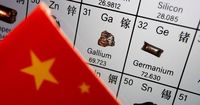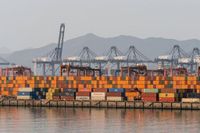China's economy is experiencing a complex interplay of growth and vulnerability as it navigates a landscape increasingly shaped by foreign demand and stringent export regulations. The latest economic data reveals that China achieved a stronger-than-expected GDP growth of 5.4% in the first quarter of 2025, with nearly 40% of this expansion attributed to net exports—the highest contribution for this period in over a decade. This marks a significant increase from the previous year, where trade contributed to almost a third of overall growth.
However, this reliance on foreign demand raises concerns about the potential impact of escalating trade tensions, particularly with the United States. As geopolitical dynamics shift, China's export controls on critical minerals and advanced technology components have further complicated its economic landscape.
In a related development, the U.S. has imposed stricter export rules on major technology firms, notably Nvidia, which have significant implications for China's burgeoning AI chip industry. The U.S. Commerce Department recently mandated that Nvidia's H20 GPUs and certain AMD chips require export licenses, effectively halting their sales to China. This decision has led to an estimated quarterly financial impact of about $5.5 billion for Nvidia, raising questions about the future of tech competition between the two nations.
As a result, local AI chip manufacturers in China, such as Huawei and Cambricon Technologies, are poised to benefit from this shift. Brady Wang, an associate director at Counterpoint Research, noted that several Chinese firms are producing competitive chips in response to the restrictions. Following the announcement of the Nvidia export controls, Cambricon's shares surged by more than 10% over the last five trading days and have increased by 400% over the past year.
Huawei is advancing its "Ascend 910" GPU series, with the latest model being the Ascend 910C. Despite facing challenges due to being placed on a U.S. blacklist, Huawei continues to make strides in chip technology. Industry analyst Doug O’Laughlin from SemiAnalysis pointed out that while Huawei may be a generation behind its competitors in chip technology, it is nonetheless making considerable progress. However, there are still gaps in its software and ecosystem readiness that need to be addressed.
Interestingly, Chinese chip manufacturers might not need to rush to meet the demand for Nvidia's H20 GPUs due to existing stockpiles and prior export exemptions. Reports indicate that Chinese firms ordered at least $16 billion worth of H20 server chips in the first quarter of 2025, providing a buffer that could allow local chipmakers to ramp up production without immediate pressure.
In another significant development, China's export controls on critical metals, including antimony, germanium, and gallium, have kept shipments at historically low levels. Since 2023, China has gradually added these metals to its export controls list, with a complete ban on exports to the U.S. implemented in December 2024. The latest customs data shows that exports of antimony and germanium products were down 57% and 39%, respectively, in the first quarter compared to the previous year. Furthermore, March exports of gallium reached their lowest level since October 2023.
The tightening of export regulations has left overseas consumers scrambling for materials, driving prices higher. For instance, the spot price of antimony in China has surged by nearly two-thirds this year, reaching a record high of 230,000 yuan ($31,509) per ton as of April 18, 2025. This price increase reflects the growing demand for these essential components in clean energy and chipmaking sectors.
Despite these challenges, analysts suggest that the effectiveness of U.S. restrictions on Chinese advancements in AI and technology may be limited. Reports indicate that Chinese firms continue to access essential foreign components and tools, even in the face of export controls. For example, TSMC is under scrutiny from the U.S. Department of Commerce for producing chips similar to those found in Huawei’s Ascend 910B processor, highlighting the complexities of global supply chains.
As China navigates this intricate economic landscape, the interplay between domestic growth and international trade will remain a critical focus. The country's increased dependence on foreign demand, coupled with the ramifications of export controls, paints a picture of an economy at a crossroads. With local companies like Huawei and Cambricon poised to capitalize on new opportunities, the future of China's tech industry may hinge on its ability to innovate and adapt in a rapidly changing global environment.
In summary, while China's economy shows signs of robust growth driven by exports, its vulnerabilities are becoming more pronounced amid escalating trade tensions and stringent export regulations. The ongoing developments in both the semiconductor and critical minerals sectors will be pivotal in shaping the trajectory of China's economic landscape in the months and years to come.






